Sources of Formaldehyde in Bountiful, Utah
Abstract
1. Introduction
2. Methods
2.1. PMF Historical Data Analysis (2004–2015 Measurements)
2.2. High Temporally Resolved Measurements (2019)
2.2.1. Criteria Gas Phase Species Measurement
2.2.2. HCHO Measurement
2.2.3. BTEX Measurement
3. Results and Discussion
3.1. Time-Integrated Historical Measurements of HCHO (2004–2017 Data)
3.2. PMF Historical Data Analysis (2004–2015 Data)
- In Factor 1, the dominant species are formaldehyde, acetaldehyde, butyraldehyde, propionaldehyde and valeraldehyde; these species are related to biomass burning emissions. Biomass burning during the winter may include residential woodburning. Factor 1 was more predominant during the wintertime for most years excluding 2005, 2006 and 2007 when the contributions from this factor were higher during summer. The higher contributions of this factor during these years corresponded to state and regional fires and high PM2.5 levels. This factor contains 45% of the formaldehyde.
- Factor 2 is dominated by high concentrations of BTEX, with 40 to 60% of these compounds being present in this factor. These emissions are consistent with expected emissions from the oil refinery complex to the SSW of the sampling site. This factor contains 5.2% of the formaldehyde.
- Factor 3 is attributed to photochemically produced formaldehyde from biogenic emissions and consists mainly of aldehydes, dominated by acetaldehyde, propionaldehyde, acetone and trans-crotonaldehyde, with 85% of the latter species in this factor. Crotonaldehyde is a product of biogenic emissions, and it is not related to industrial emissions. As expected, contributions were more predominant during summertime. This factor contains 34% of the formaldehyde.
- Factor 4 contains 100% of the PM2.5 and 34% of the NOX, with the contributions from all other species varying from 4 to 15%. We attribute this factor to mobile emissions. It contains 7.1% of the formaldehyde.
- Factor 5, similar to Factor 2 is dominated by high concentrations of BTEX, containing 22 to 65% of these compounds. It also contains 62% of the NOX. We attribute this factor to industrial emissions, possibly related to refinery emissions. This factor contains 8.4% of the formaldehyde. The principal difference between Factor 5 and Factor 2 is that Factor 5 contains 62% of the NOX while Factor 2 contains no NOX. Factor 5 is also much higher in propylene and acetylene. Both factors are probably associated with refinery emissions but reflect contribution from different processes at the refinery. They have been given different names for clarity.
3.3. Concentration Rose Plots and Wind Direction of Historical Data (2004–2015 Data)
3.4. High Temporally Resolved Measurements Results (2019)
3.5. Relationship between Formaldehyde and BTEX
3.6. Relationship between Formaldehyde and O3
3.7. Backwind Trajectory Analysis of High-Resolution Measurements
4. Conclusions
Supplementary Materials
Author Contributions
Funding
Institutional Review Board Statement
Informed Consent Statement
Data Availability Statement
Acknowledgments
Conflicts of Interest
References
- Strum, M.; Scheffe, R. National review of ambient air toxics observations. J. Air Waste Manag. Assoc. 2016, 66, 120–133. [Google Scholar] [CrossRef]
- U.S. Department of Health and Health Services. Public Health Statement for Formaldehyde. Available online: https://www.atsdr.cdc.gov/ToxProfiles/tp111-c1-b.pdf (accessed on 21 January 2021).
- IARC Monographs on the Evaluation of Carcinogenic Risks to Humans Volume 88: Formaldehyde, 2-Butoxyethanol and 1-tert-Butoxypropan-2-ol. 2006. Available online: https://monographs.iarc.who.int/wp-content/uploads/2018/06/mono88.pdf (accessed on 10 March 2021).
- U.S. Environmental Protection Agency. Report to Congress on Indoor Air Quality, Volume II: Assessment and Control of Indoor Air Pollution; U.S. Environmental Protection Agency: Washington, DC, USA, 1989. [Google Scholar]
- Bulatov, V.P.; Kozliner, M.Z.; Sarkisov, O.M. Determination of rate constants for the reactions SH+ NO2−HSO+ NO and HSO+ NO2 products. Khim. Fiz. 1984, 3, 1300–1305. [Google Scholar]
- U.S. Department of Health and Human Services. Public Health Statement for Formaldehyde. Available online: https://www.atsdr.cdc.gov/toxprofiles/tp111-c1.pdf (accessed on 10 March 2021).
- Zhu, L.; Jacob, D.J.; Keutsch, F.N.; Mickley, L.J.; Scheffe, R.; Strum, M.; Abad, G.G.; Chance, K.; Yang, K.; Rappengluck, B.; et al. Formaldehyde (HCHO) As a Hazardous Air Pollutant: Mapping Surface Air Concentrations from Satellite and Inferring Cancer Risks in the United States. Environ. Sci. Technol. 2017, 51, 5650–5657. [Google Scholar] [CrossRef] [PubMed]
- Luo, Y.H.; Dou, K.; Fan, G.Q.; Huang, S.; Si, F.Q.; Zhou, H.J.; Wang, Y.J.; Pei, C.L.; Tang, F.Y.; Yang, D.S.; et al. Vertical distributions of tropospheric formaldehyde, nitrogen dioxide, ozone and aerosol in southern China by ground-based MAX-DOAS and LIDAR measurements during PRIDE-GBA 2018 campaign. Atmos. Environ. 2020, 226, 11. [Google Scholar] [CrossRef]
- Pfister, G.; Wang, C.T.; Barth, M.; Flocke, F.; Vizuete, W.; Walters, S. Chemical Characteristics and Ozone Production in the Northern Colorado Front Range. J. Geophys. Res. Atmos. 2019, 124, 13397–13419. [Google Scholar] [CrossRef]
- Xu, R.J.; Li, X.; Dong, H.B.; Wu, Z.J.; Chen, S.Y.; Fang, X.; Gao, J.; Guo, S.; Hu, M.; Li, D.Q.; et al. Measurement of gaseous and particulate formaldehyde in the Yangtze River Delta, China. Atmos. Environ. 2020, 224, 11. [Google Scholar] [CrossRef]
- Zeng, P.; Lyu, X.P.; Guo, H.; Cheng, H.R.; Wang, Z.W.; Liu, X.F.; Zhang, W.H. Spatial variation of sources and photochemistry, of formaldehyde in Wuhan, Central China. Atmos. Environ. 2019, 214, 9. [Google Scholar] [CrossRef]
- Kumar, A.; Bali, K.; Singh, S.; Naja, M.; Mishra, A.K. Estimates of reactive trace gases (NMVOCs, CO and NOx) and their ozone forming potentials during forest fire over Southern Himalayan region. Atmos. Res. 2019, 227, 41–51. [Google Scholar] [CrossRef]
- Adeniji, S.A.; Kerr, J.A.; Williams, M.R. Rate Constants for Ozone-Alkene Reactions under Atmospheric Conditions. Int. J. Chem. Kinet. 1981, 13, 209. [Google Scholar] [CrossRef]
- Zhang, H.L.; Li, J.Y.; Ying, Q.; Guven, B.B.; Olaguer, E.P. Source apportionment of formaldehyde during TexAQS 2006 using a source-oriented chemical transport model. J. Geophys. Res. Atmos. 2013, 118, 1525–1535. [Google Scholar] [CrossRef]
- Parrish, D.D.; Ryerson, T.B.; Mellqvist, J.; Johansson, J.; Fried, A.; Richter, D.; Walega, J.G.; Washenfelder, R.A.; de Gouw, J.A.; Peischl, J.; et al. Primary and secondary sources of formaldehyde in urban atmospheres: Houston Texas region. Atmos. Chem. Phys. 2012, 12, 3273–3288. [Google Scholar] [CrossRef]
- Stroud, C.A.; Zaganescu, C.; Chen, J.; McLinden, C.A.; Zhang, J.H.; Wang, D. Toxic volatile organic air pollutants across Canada: Multi-year concentration trends, regional air quality modelling and source apportionment. J. Atmos. Chem. 2016, 73, 137–164. [Google Scholar] [CrossRef]
- Patrick Barickman, M.B.; Daher, N.; Kelly, K.; Packham, S. 2015 Special Toxics Study Report; Utah Division of Air Quality: Salt Lake City, UT, USA, 2016. [Google Scholar]
- Kelly, K.; Daher, N. Saturation Air Toxics Monitoring in Davis County, Utah; Utah Division of Air Quality: Salt Lake City, UT, USA, 2017. [Google Scholar]
- Utah Department of Transportation Annual Averge Daily Traffice (AADT) for Roadway Segments in Utah. Available online: https://www.udot.utah.gov/connect/docs/aadt-google-map/ (accessed on 11 January 2021).
- U.S. Environmental Protection Agency Determination of Formaldehyde in Ambient Air Using Adsorbent Cartridge Followed by High Performance Liquid Chromatography. Available online: https://www.epa.gov/sites/production/files/2019-11/documents/to-11ar.pdf (accessed on 21 January 2021).
- U.S. Environmental Protection Agency Formaldehyde. Available online: https://www.epa.gov/sites/production/files/2016-09/documents/formaldehyde.pdf (accessed on 21 January 2021).
- Paatero, P. Least squares formulation of robust non-negative factor analysis. Chemom. Intell. Lab. Syst. 1997, 37, 23–35. [Google Scholar] [CrossRef]
- U.S. Environmental Protection Agency. EPA Positive Matrix Factorization (PMF) 5.0 Fundamental and User Guide; EPA/600/R-14/108; U.S. Environmental Protection Agency: Washington, DC, USA, 2018. [Google Scholar]
- Polissar, A.V.; Hopke, P.K.; Paatero, P. Atmospheric aerosol over Alaska—2. Elemental composition and sources. J. Geophys. Res. Atmos. 1998, 103, 19045–19057. [Google Scholar] [CrossRef]
- Washenfelder, R.A.; Attwood, A.R.; Flores, J.M.; Zarzana, K.J.; Rudich, Y.; Brown, S.S. Broadband cavity-enhanced absorption spectroscopy in the ultraviolet spectral region for measurements of nitrogen dioxide and formaldehyde. Atmos. Meas. Tech. 2016, 9, 41–52. [Google Scholar] [CrossRef]
- Thalman, R.; Zarzana, K.J.; Tolbert, M.A.; Volkamer, R. Rayleigh scattering cross-section measurements of nitrogen, argon, oxygen and air. J. Quant. Spectrosc. Radiat. Transf. 2014, 147, 171–177. [Google Scholar] [CrossRef]
- Jenkin, M.E.; Saunders, S.M.; Pilling, M.J. The tropospheric degradation of volatile organic compounds: A protocol for mechanism development. Atmos. Environ. 1997, 31, 81–104. [Google Scholar] [CrossRef]
- Saunders, S.M.; Jenkin, M.E.; Derwent, R.G.; Pilling, M.J. Protocol for the development of the Master Chemical Mechanism, MCM v3 (Part A): Tropospheric degradation of non-aromatic volatile organic compounds. Atmos. Chem. Phys. 2003, 3, 161–180. [Google Scholar] [CrossRef]
- Jenkin, M.E.; Saunders, S.M.; Wagner, V.; Pilling, M.J. Protocol for the development of the Master Chemical Mechanism, MCM v3 (Part B): Tropospheric degradation of aromatic volatile organic compounds. Atmos. Chem. Phys. 2003, 3, 181–193. [Google Scholar] [CrossRef]
- Bloss, C.; Wagner, V.; Jenkin, M.E.; Volkamer, R.; Bloss, W.J.; Lee, J.D.; Heard, D.E.; Wirtz, K.; Martin-Reviejo, M.; Rea, G.; et al. Development of a detailed chemical mechanism (MCMv3.1) for the atmospheric oxidation of aromatic hydrocarbons. Atmos. Chem. Phys. 2005, 5, 641–664. [Google Scholar] [CrossRef]
- Sommariva, R.; Cox, S.; Martin, C.; Borońska, K.; Young, J.; Jimack, P.K.; Pilling, M.J.; Matthaios, V.N.; Nelson, B.S.; Newland, M.J.; et al. AtChem (version 1), an open-source box model for the Master Chemical Mechanism. Geosci. Model Dev. 2020, 13, 169–183. [Google Scholar] [CrossRef]
- Finlayson-Pitts, B.J. Chemistry of the Upper and Lower Atmosphere: Theory, Experiments, and Applications; Pitts, J.N., Ed.; Academic Press: San Diego, CA, USA, 2000. [Google Scholar]
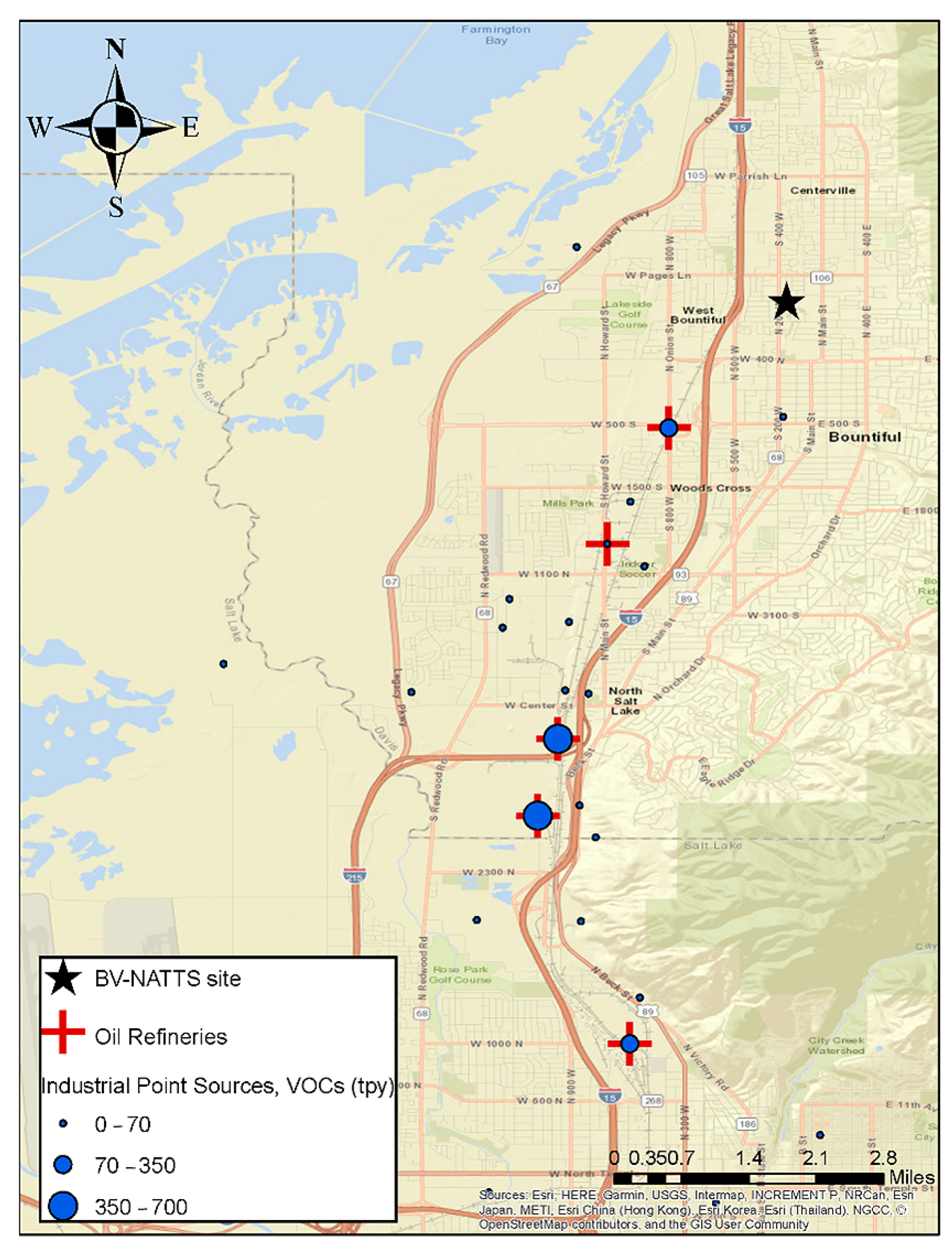
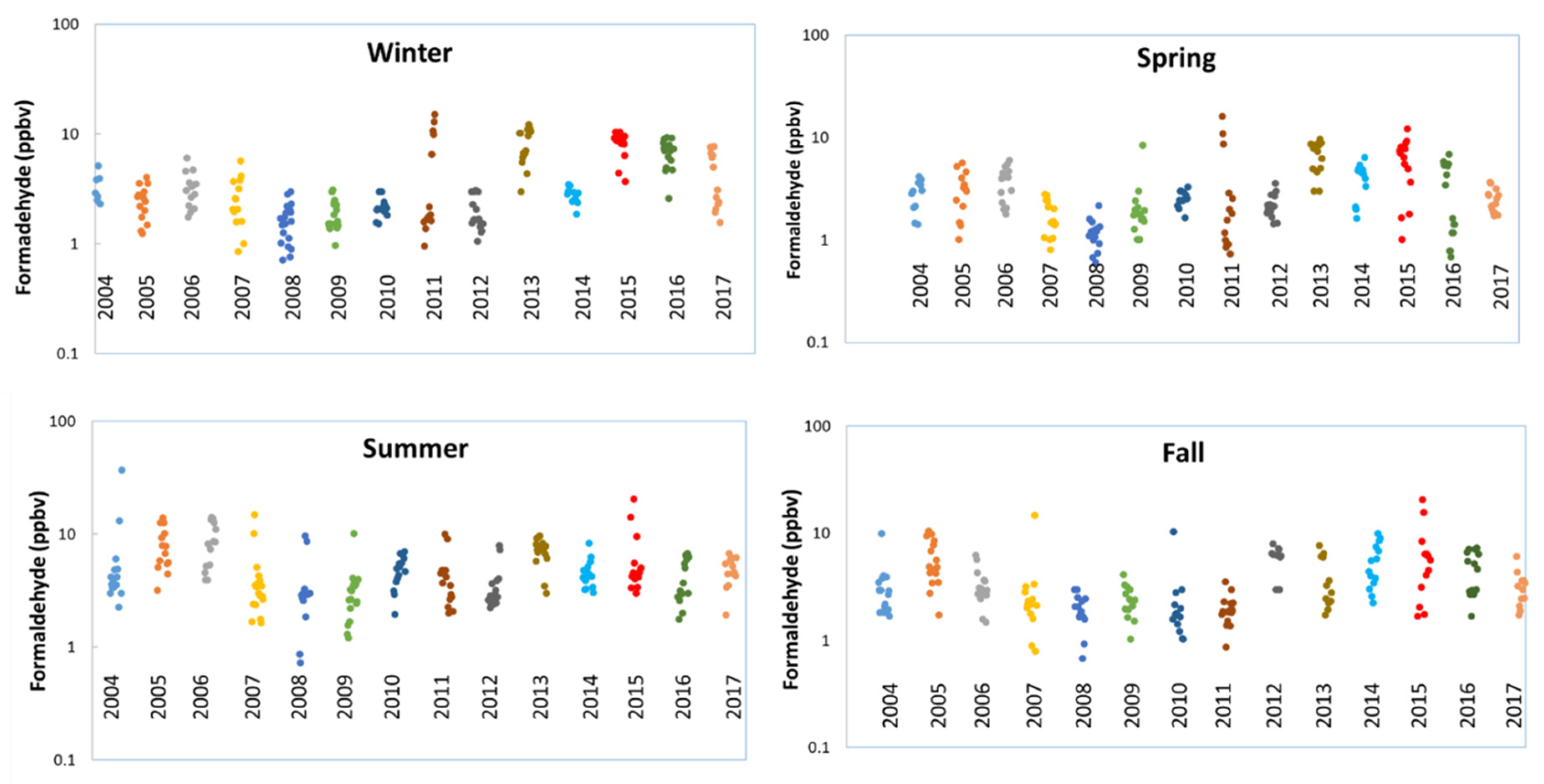
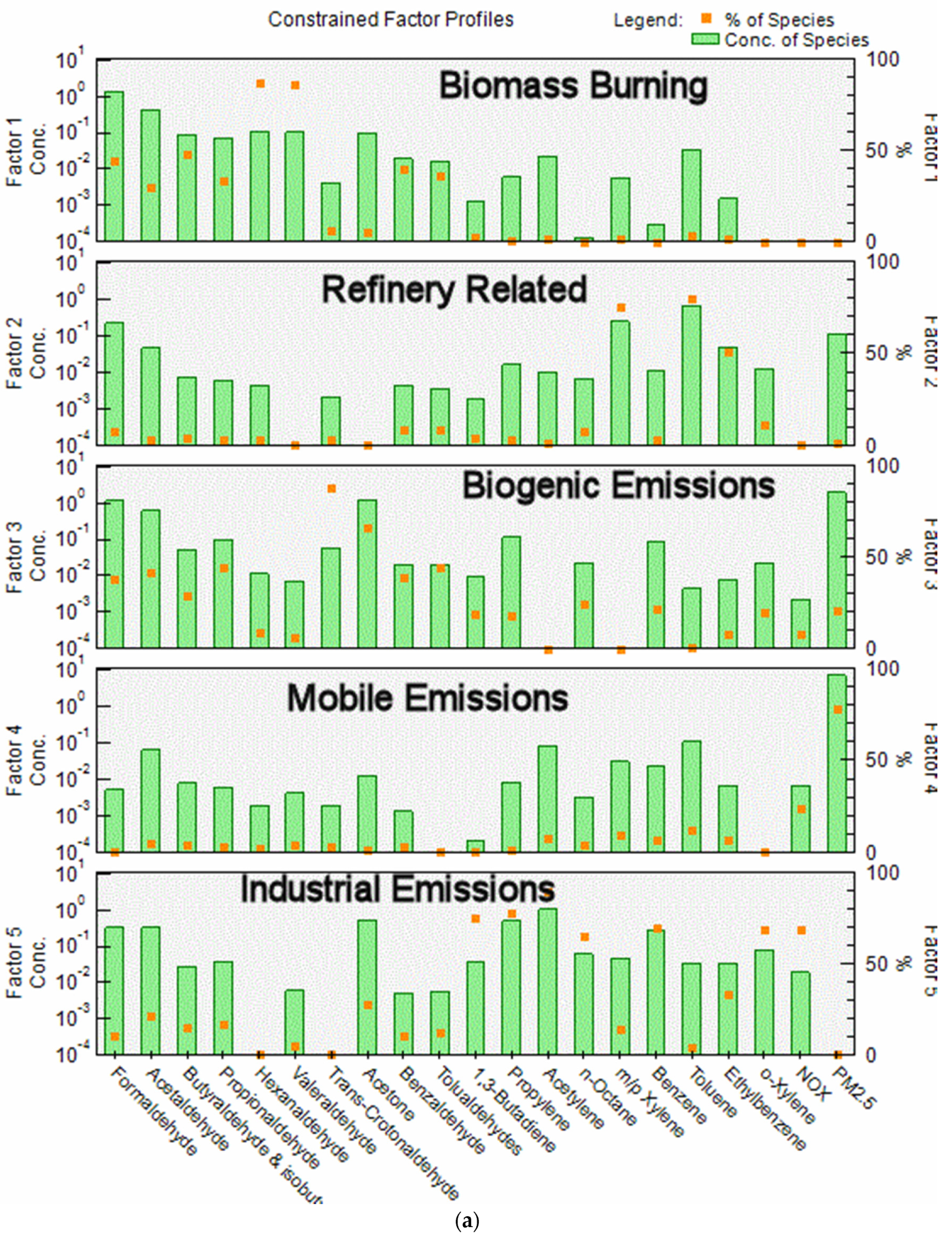
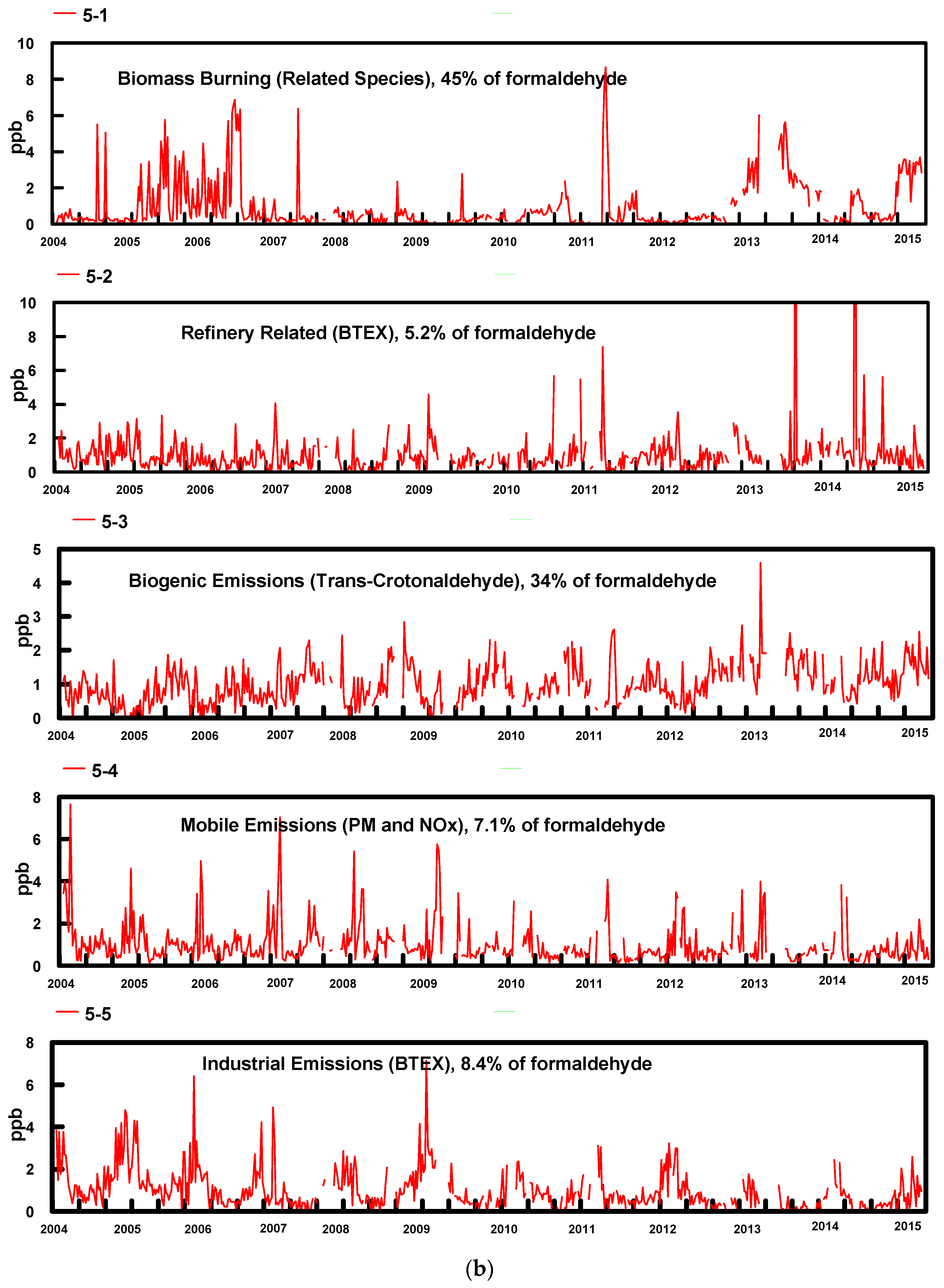
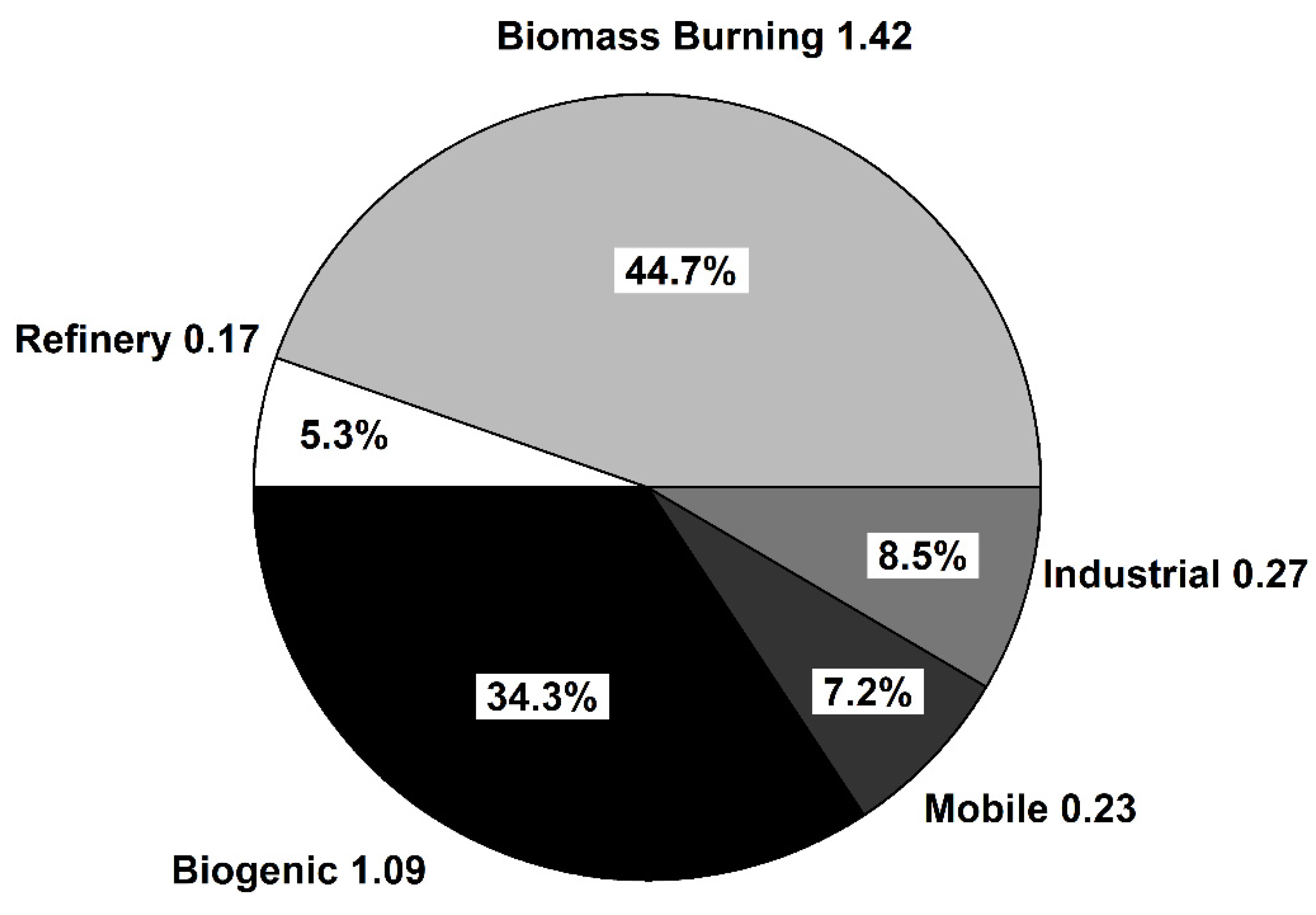
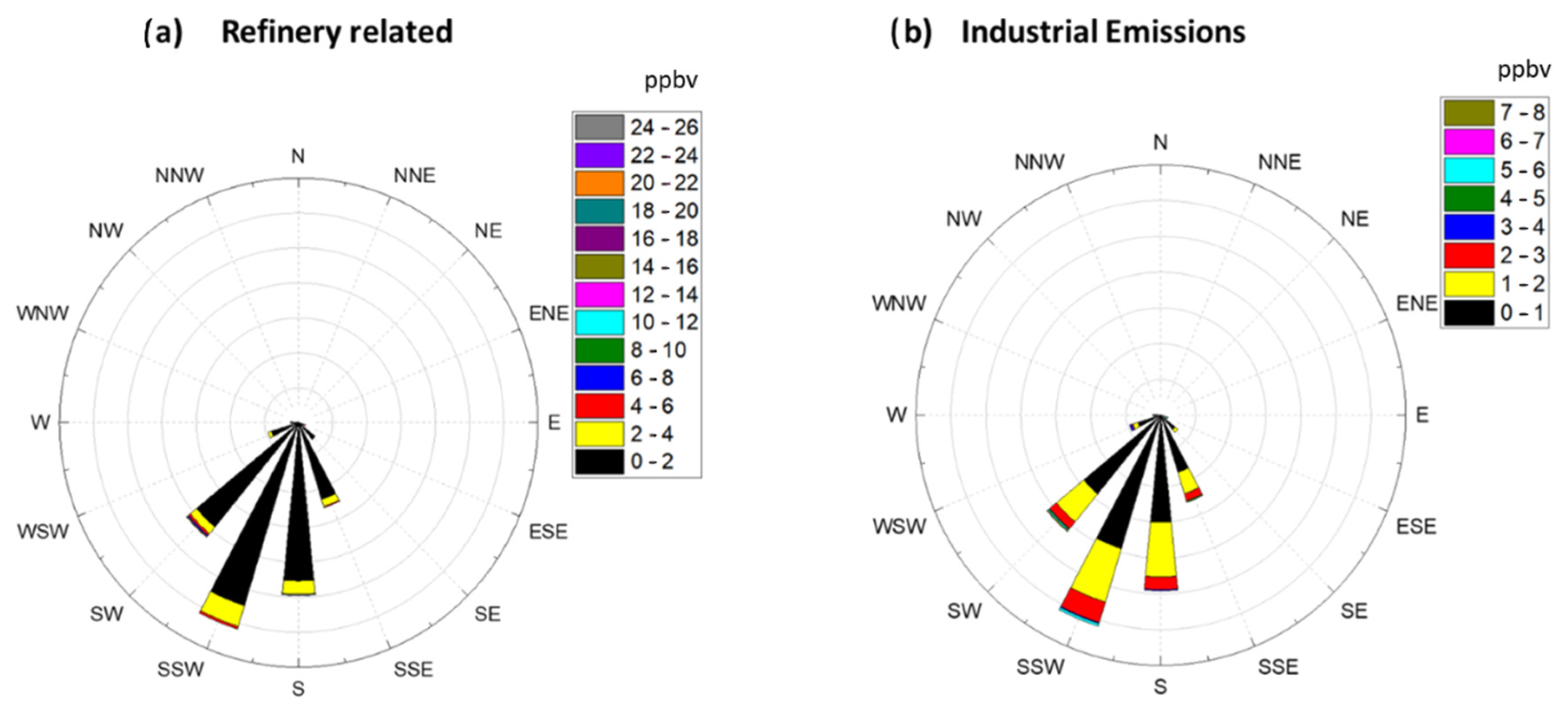
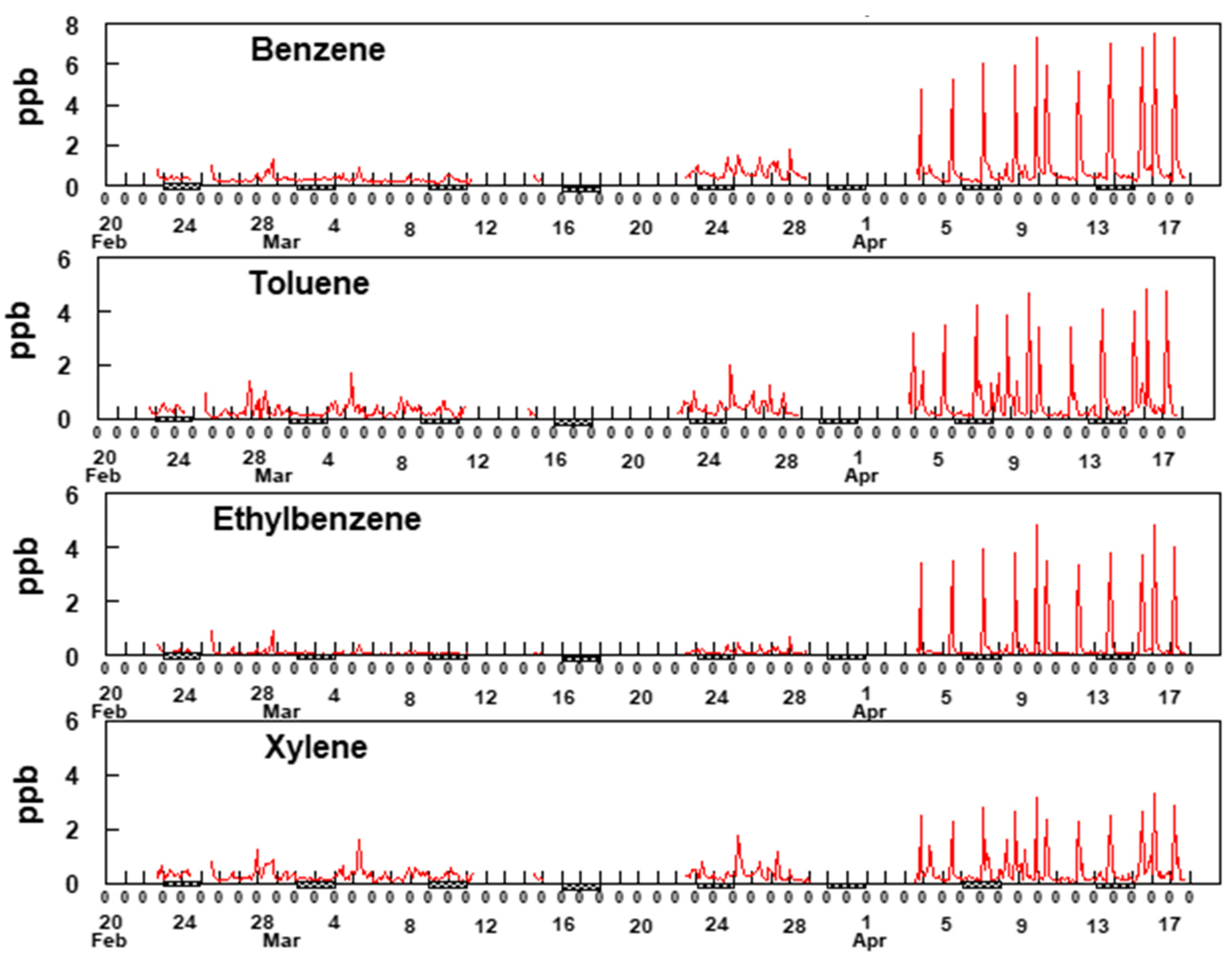
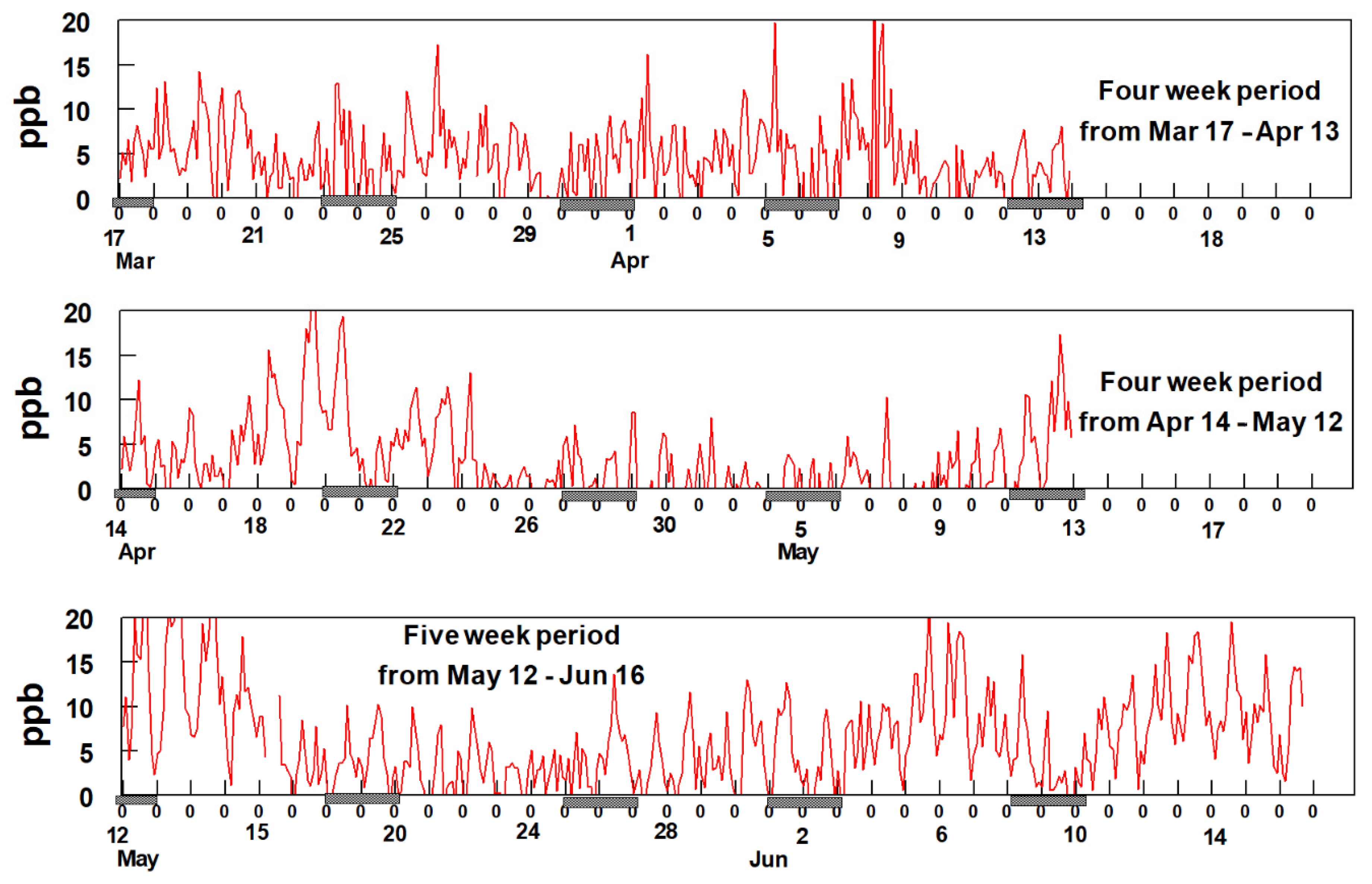
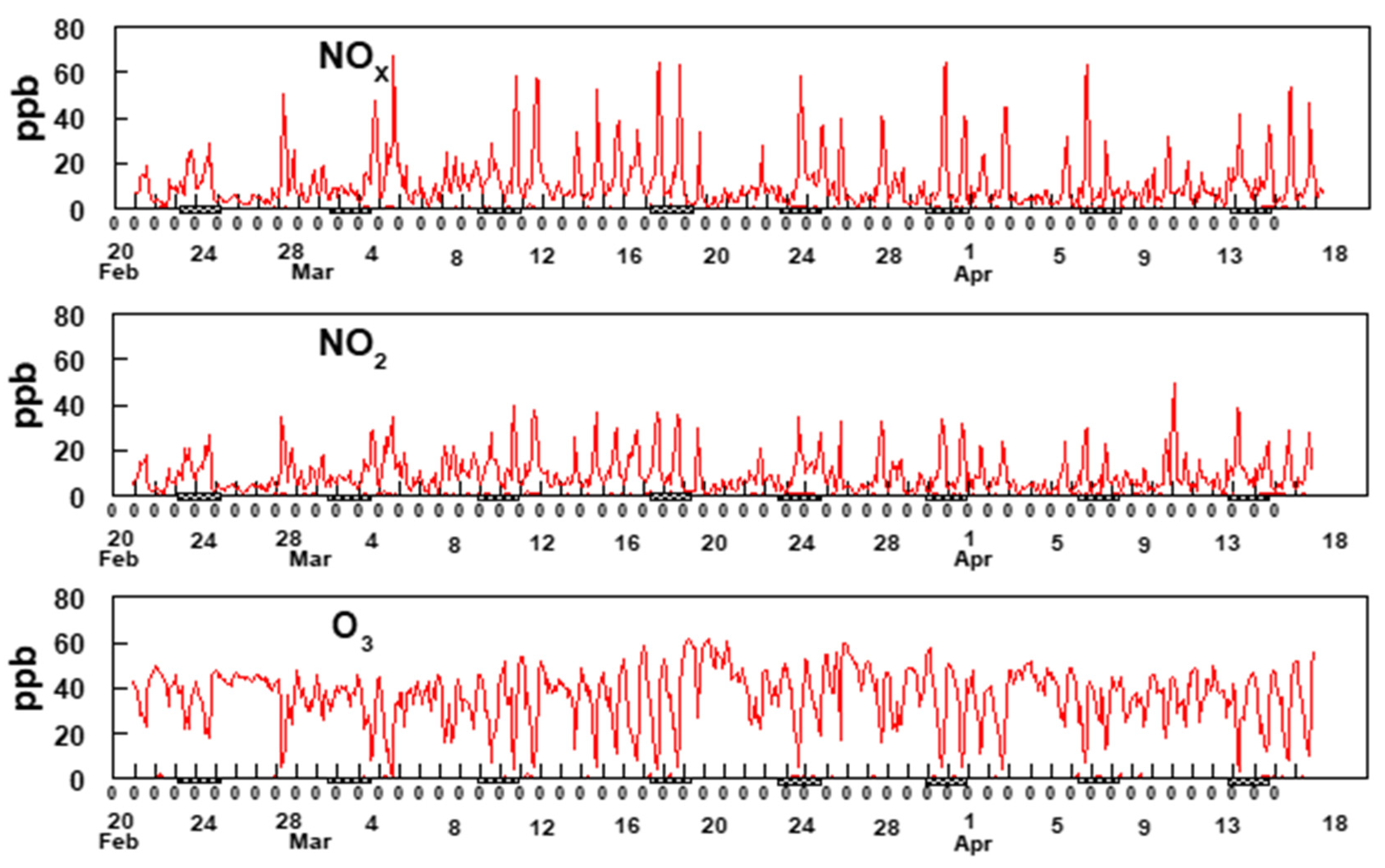

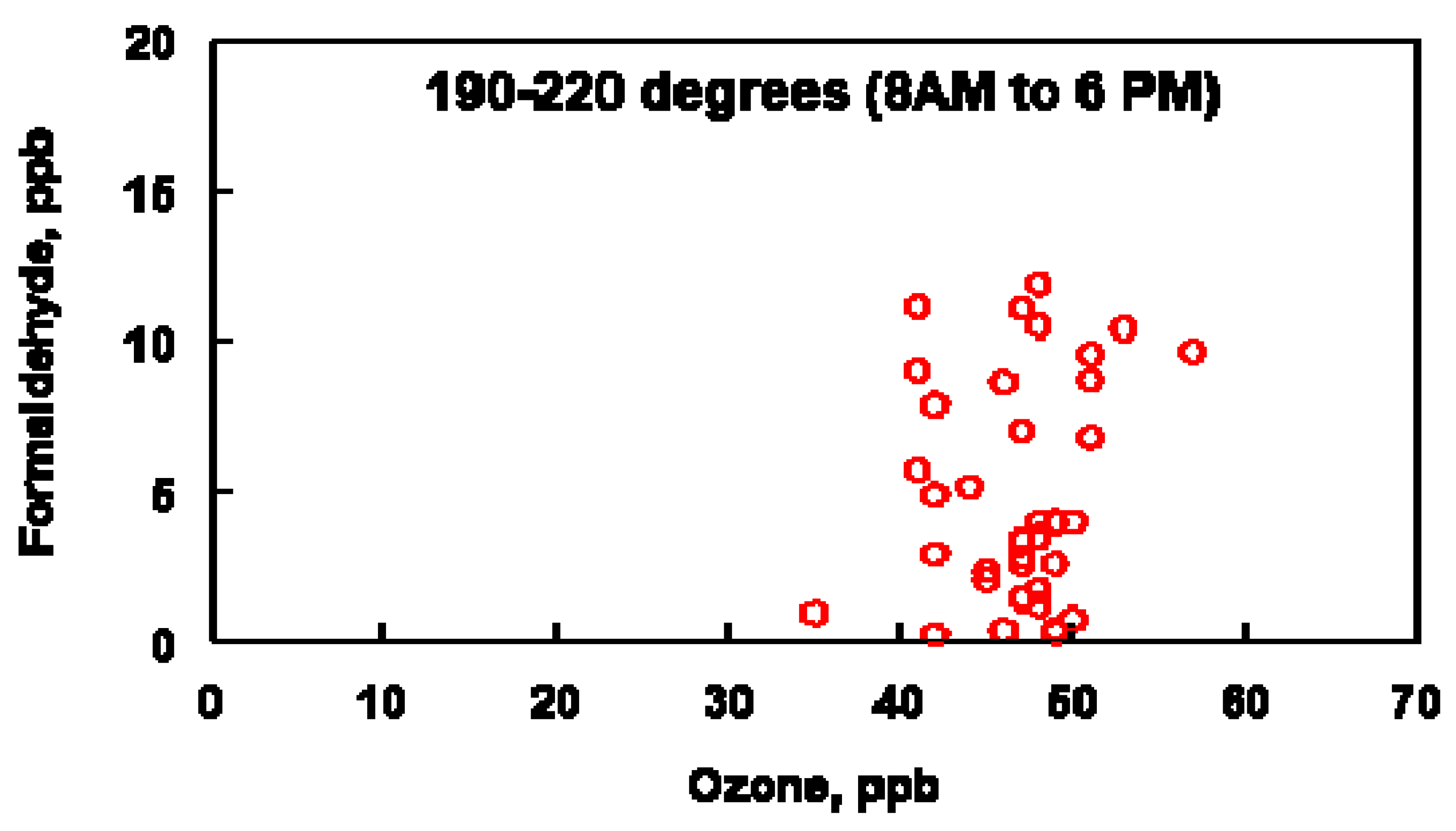
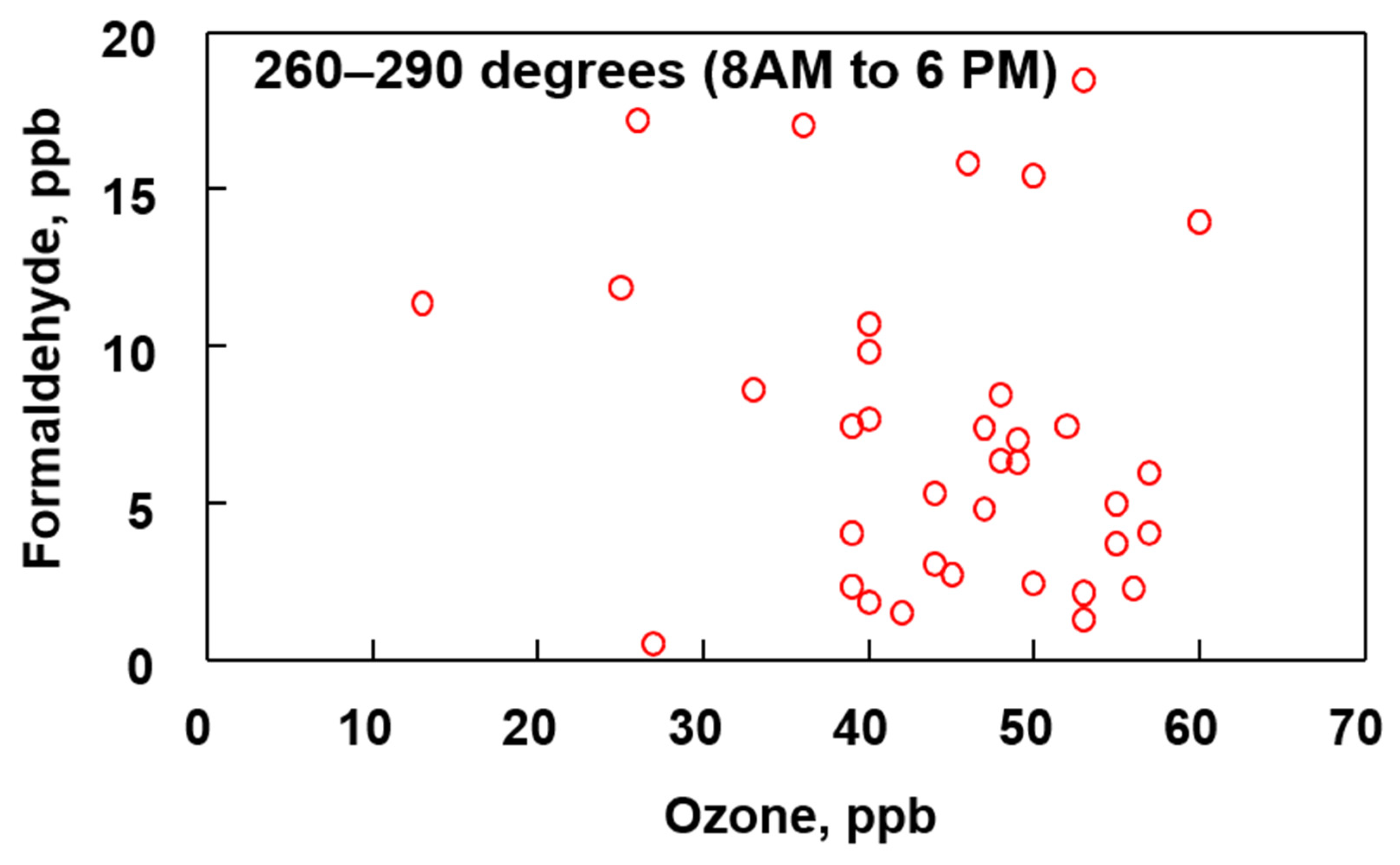

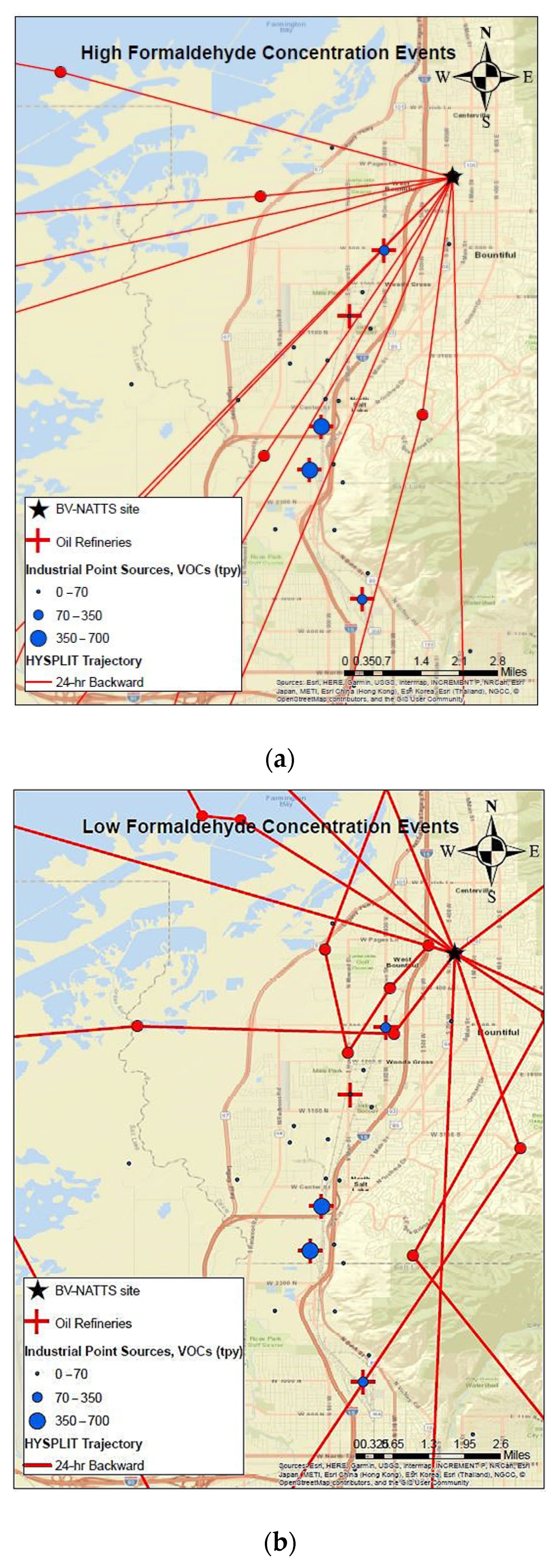
| Acetaldehyde (0.1) | Ethylbenzene (0.1) | Propylene (0.1) |
| Acetone (0.1) | Formaldehyde (0.1) | Tolualdehydes (0.1) |
| Acetylene (0.1) | Hexanaldehyde (0.1) | Toluene (0.1) |
| Benzaldehyde (0.1) | NOX (10) | Trans-Crotonaldehyde (0.1) |
| Benzene (0.1) | PM2.5 (2) | Valeraldehyde (0.1) |
| 1,3-Butadiene (0.1) | n-Octane (0.1) | m/p Xylene (0.1) |
| Butyraldehyde & isobutyraldehyde (0.1) | Propionaldehyde (0.1) |
| Date | <3 (ppbv) | % | 3–10 (ppbv) | % | 10–15 (ppbv) | % | 15–36 (ppbv) | % |
|---|---|---|---|---|---|---|---|---|
| Monday | 63 | 14 | 48 | 13 | 3 | 10 | 1 | 17 |
| Tuesday | 57 | 13 | 59 | 16 | 3 | 10 | 1 | 17 |
| Wednesday | 64 | 14 | 55 | 15 | 4 | 14 | 0 | 0 |
| Thursday | 65 | 15 | 52 | 14 | 5 | 17 | 1 | 17 |
| Friday | 63 | 14 | 53 | 14 | 5 | 17 | 2 | 33 |
| Saturday | 65 | 15 | 54 | 15 | 5 | 17 | 1 | 17 |
| Sunday | 65 | 15 | 48 | 13 | 4 | 14 | 0 | 0 |
| Number of Samples | 442 | 100 | 369 | 100 | 29 | 100 | 6 | 100 |
Publisher’s Note: MDPI stays neutral with regard to jurisdictional claims in published maps and institutional affiliations. |
© 2021 by the authors. Licensee MDPI, Basel, Switzerland. This article is an open access article distributed under the terms and conditions of the Creative Commons Attribution (CC BY) license (http://creativecommons.org/licenses/by/4.0/).
Share and Cite
Bhardwaj, N.; Kelsch, A.; Eatough, D.J.; Thalman, R.; Daher, N.; Kelly, K.; Jaramillo, I.C.; Hansen, J.C. Sources of Formaldehyde in Bountiful, Utah. Atmosphere 2021, 12, 375. https://doi.org/10.3390/atmos12030375
Bhardwaj N, Kelsch A, Eatough DJ, Thalman R, Daher N, Kelly K, Jaramillo IC, Hansen JC. Sources of Formaldehyde in Bountiful, Utah. Atmosphere. 2021; 12(3):375. https://doi.org/10.3390/atmos12030375
Chicago/Turabian StyleBhardwaj, Nitish, Ariel Kelsch, Delbert J. Eatough, Ryan Thalman, Nancy Daher, Kerry Kelly, Isabel Cristina Jaramillo, and Jaron C. Hansen. 2021. "Sources of Formaldehyde in Bountiful, Utah" Atmosphere 12, no. 3: 375. https://doi.org/10.3390/atmos12030375
APA StyleBhardwaj, N., Kelsch, A., Eatough, D. J., Thalman, R., Daher, N., Kelly, K., Jaramillo, I. C., & Hansen, J. C. (2021). Sources of Formaldehyde in Bountiful, Utah. Atmosphere, 12(3), 375. https://doi.org/10.3390/atmos12030375







